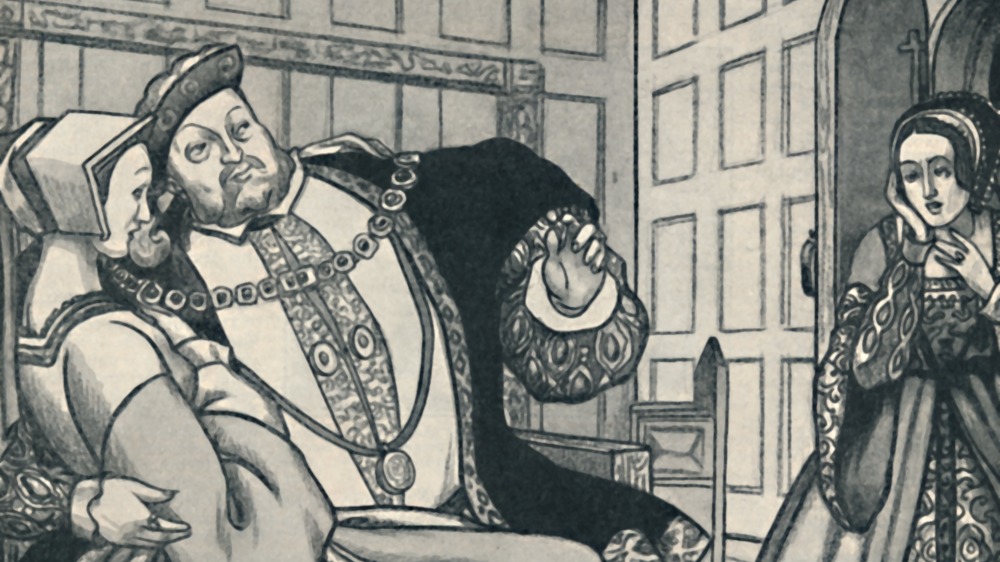The Sometimes Tragic History Of Divorce
It's a common refrain when we talk about marriage: half of those in the United States end in divorce. It's one of those urban legends most people believe without a second thought, like how daddy longlegs are the most poisonous spiders in the world (they aren't) or that the guys from Kiss are actually Knights in Satan's Service (they aren't, they're just a poor excuse for a rock band). Luckily, as Fatherly reported in November 2020, the data employed to create that outrageous statistic is flawed and unreliable, and the real rate is much lower than that. In fact, the U.S. divorce rate reached a record low in 2019, when only around 15 out of every 1,000 marriages ended in divorce. That was the lowest figure on that chart since 1970.
But the divorce rate isn't the only trend seeing a downturn. According to the Institute for Family Studies, the marriage rate in the United States also reached an all-time low in 2019, with 33 out of every 1,000 single Americans getting married that year, a downtrend that began after its peak of 86 in 1970. While it can be difficult to pin down the exact numbers for these trends, and different sources cite varying data, one thing is for sure: the way people pair up in the United States is changing. So let's take a look at the often tragic — but sometimes humorous — history of divorce in the western world.
The first divorce in the Western world
In her 2014 article in Smithsonian magazine, Dr. Amanda Foreman detailed how divorce has always had more dire consequences for women than for the men involved. "For centuries, divorce in the West was a male tool of control," she wrote, "a legislative chastity belt designed to ensure that a wife had one master, while a husband could enjoy many mistresses." And that tradition began with Henry VIII, who quarreled with the Roman Catholic Church in 1527, when he wanted out of his marriage to Catherine of Aragon. But since Pope Clement VII wouldn't budge, Henry decided he'd just divorce his whole domain from the Catholic Church in 1533. He declared himself the leader of the newly formed Church of England and married his new squeeze, Anne Boleyn.
After Boleyn was unable to give Henry a male heir, he trumped up some charges of treason, adultery, and incest in order to end that marriage. He had bishops in the church he now controlled annul the marriage two days before she was executed, so that he could sleep well at night in the belief that he wasn't a wife killer. Although it's widely believed that the allegations were unfounded, Anne Boleyn was remembered as "the original homewrecker" who was the first to destroy the sanctity of marriage and set loose the hounds of divorce on the good people of England.
Divorce has always affected women more seriously than men
Despite that reputation, there was only one such separation after her death, in 1552, and the word wasn't even used again for more than a century. The Church of England vehemently opposed the dissolution of a marriage, and when a law allowing for divorce was finally instituted in 1857, only 324 marriages had ended in the preceding three centuries. And a paltry four of those had been initiated by women. Back then, it was much easier for a man to find legal grounds for a divorce than for a woman. All he had to do was prove that his wife had committed adultery. Wives, on the other hand, had to prove other egregious conditions on top of a husband's adultery. Violence, rape, economic exploitation, and outright desertion didn't count.
One such condition was impotence. If a marriage was unable to be consummated, a wife had grounds for divorce. Bigamy and the wife being underage at the time of the wedding were also valid grounds, and were actually quite common before records began to be dutifully and legal kept in 1753. Another was when the husband turned out to be a wife, which actually happened in 1680, when Arabella Hunt discovered that the man she'd married under the name "James Howard" was really a woman named Amy Poulter. Although still not perfect, the institution of divorce has become quite a bit more equitable over the intervening centuries.


